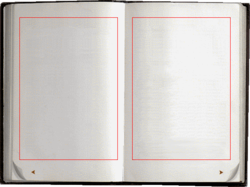Where in Time is Carmen Sandiego? (1997)
| Where in Time is Carmen Sandiego? |
|---|
|
Also known as: Carmen Sandiego's Great Chase Through Time (1999)
|
CALLING ALL TIME PILOTS! Carmen Sandiego has just broken into ACME headquarters, stolen the only time travel device on the planet, and gone on a rampage across history with her gang of crooks. It's up to YOU to stop her!
Reports indicate she was last sighted in the offices of Brøderbund Software circa 1997 stealing over 400 lines of dialogue from the script of Where in Time is Carmen Sandiego?, the 1997 remake/reimagining of the 1989 educational game that made learning fun!... maybe.
Ancillary evidence further shows that Carmen had a go at the game's demo version, removing some truly hideous animations and block paragraphs.
Contents
Sub-Pages
| Prototype Info |
| Unused Dialogue I hope you're ready for a history lesson. And a lot of people telling you the Time Cuffs aren't active yet. |
The Case of the Missing Case
While the game's first case (Egypt) is followed directly by the Rome case in-game, internally, Rome is actually the third case. The second case is skipped over in the names of the case files (e.g. Egypt's main resource file is C1ART.MHK, while Rome's is C3ART.MHK). Case 2 simply doesn't exist.
There are almost no traces of the missing case in the game data. The only acknowledgement that it was even planned seems to be this placeholder Chronopedia entry:
HISTORY TEXT FOR CASE 2 Section 1 Heading Section 1 Body. Section 2 Heading Section 2 Body. Section 3 Heading Section 3 Body. Section 4 Heading Section 4 Body.
It seems to have been cut fairly early in development, as the demo version (dated three months before the final) contains a case timeline that doesn't show anything between the Egypt and Rome cases. Most likely it was scrapped shortly into the process of implementing the game and never actually developed; if it existed, there would be an even 20 cases.
There are a few reasonable inferences to be made regarding its content:
- The case would have taken place sometime between 1490 BCE and 50 BCE.
- The villain would certainly have been Dee Cryption, who appears both in the game's intro and in the jailbreak scene at the start of Disc 2 but isn't in any of the Disc 1 cases.
- The Good Guide would probably have been Polly Tix, who stars in a measly two cases versus four each for the other Guides.
Other than that, it's anyone's guess what it would have involved.
For clarity, this article labels the remainder of the cases according to their internal number, so Rome is Case 3.
Graphics
Case 11: Spain, 1493

|
A single frame showing the head of the shark that appears in certain parts of the ocean. Only its dorsal fin is ever normally seen. This would have gone along much better with Rock's commentary on the size of its teeth. |
| An icon of a map or sea chart. It's stored as a static image like the backgrounds instead of as part of an animation (unlike proper inventory items), and it's stored alongside a static duplicate of the sea chart's inventory icon (whose proper graphics are contained in an animation). May have been associated with the maps in Isabella's room, which as evidenced by some unused dialogue were intended to be movable. |
Case 13: Aztec Empire, 1519
| Originally, there was a third component to this case's trading sidequest: one of the gold nuggets for Montezuma's headdress was missing, and the player had to pick up a third cocoa pot from the throne room and trade it for a nugget in the marketplace. This wound up getting cut, perhaps to avoid exceeding the four-item inventory limit, but a few traces remain. The graphics for the third cocoa pot in Montezuma's chamber are still there, as are the graphics for the nuggets in the marketplace (the second graphic is duplicated to make a group of three, as with the other marketplace items). There are also a couple of unused dialogue lines related to this. |
Case 16: Northwest USA, 1805
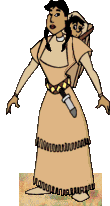
|
At one point, this case had another trading item: a rattle. Most traces of it were wiped from the game, but in addition to a few lines of dialogue, this animation of Sacajawea performing the hand sign needed to trade for it survived to the finished game.
It's not clear whether it was supposed to exist alongside the five used items or if it was removed and replaced by something else. Most likely it was just another red herring, or possibly a different way to get past the bear. |
Case 18: USA, 1879
Case 19: USSR, 1961
| Used | Unused |
|---|---|
 |
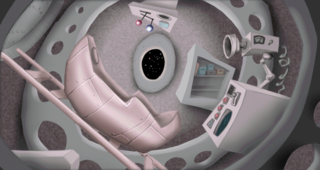 |
Here's what the capsule background looks like with and without the extra graphic.
Chronopedia
| Early | Final |
|---|---|
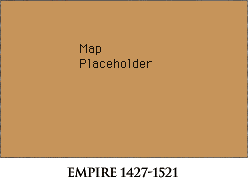 |
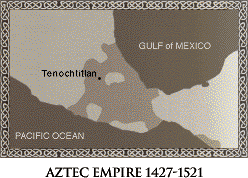 |
There's also this placeholder graphic for the Aztec Empire map. Apparently someone wasn't quite sure about the name.
Miscellaneous
Music
Theme Song
As a bonus, both game CDs contain identical Redbook audio sectors with a copy of the theme song to the Where in Time is Carmen Sandiego? game show that was on the air at the time. This is probably the only official release of the song in any form.
Case 7: China, 1271
The music for the map shown between screens in Case 7 is too long to be heard in full.
Case 11: Spain, 1493
A downbeat, dramatic orchestral piece. It's somewhat similar to the music used after discovering Columbus's crew, so it might have originally been for that.
A short, tense track. It's a little Jaws-like, so maybe it was supposed to play when the shark showed up?
Case 13: Aztec Empire, 1519
This fanfare is almost certainly supposed to play as Buggs Zapper is recaptured, but seems to have been the victim of an audio miscue: the music from the marketplace plays instead.
Case 16: Northwest USA, 1805
As with the China case, the map screen is never shown long enough to hear this track in full.
Case 18: USA, 1879
A short rag. May have been meant as background music for arresting Dee Cryption.
Dialogue: The Short Version
This game has a lot of unused dialogue (in the ballpark of 400 lines!). It's documented in excruciating, nauseating detail on the sub-page, but for those who don't have time to kill, here's the digest.
Each section header links to the corresponding section of the sub-page.
General
- Lots of characters have alternate greetings that they're supposed to say from the third time they're talked to onwards or after meeting specific conditions, but only a handful are ever used.
- Many cut audio files have been partially deleted by silencing the audio, but the subtitles often still remain.
- Almost every case has special dialogue to be played when the Time Cuffs are used before they're active, but it's never heard because trying to do so just plays their inventory description instead.
- A good number of cases have four lines that are meant to play at random when the Good Guide is clicked, but only the first three are ever used.
- Nearly every case contains subtitles and sometimes duplicate dialogue for the conversation between the Good Guide and the villain that plays in the Time Tunnel after the arrest, but they're never used.
- The first Carmen Note piece was originally under the boatman's bag on the Nile bank, but was moved to Hatshepsut's temple.
- The developers planned for it to be possible to use the Time Cuffs on Julius Caesar, but in the finished game this turned out to be impossible.
- The cracked stone used to retrieve the grapes was supposed to be an interactive object named "Platform", but ended up being plot scenery.
- The developers apparently weren't sure whether they'd let the player leave the shore area without first talking to Leif Eriksson, so they wrote dialogue for both situations.
- Tyrkir the Southerner is actually from Germany.
- The scene where the Vikings reclaim their ship was supposed to feature Leif egging the crew on.
- Baron Grinnit was originally named "Baron Wasteland", after a character from the WiTiCS game show. His name was changed after the dialogue was recorded, necessitating some hasty cuts (and also causing his full name to appear only in the manual).
- The boat on the byoubu in the Spring House was supposed to be clickable and have its own description, but this got cut for some reason.
- A bug prevents a snippet of dialogue with the Spring House guard from playing.
- It was supposed to be possible to use the Time Cuffs on Murasaki, the guards, and several other objects besides Murasaki's drawers, but the game doesn't allow it.
- Surprisingly, some plot railroading was actually cut from this triple fetch quest.
- A partially deleted line suggests Polly Tix was going to try her hand at falconry.
- Apparently someone on the editing team was averse to oil puns.
- Apparently someone on the editing team was also averse to salt puns.
- It was supposed to be possible to try (and fail) to trade things other than the gold pieces with the salt trader.
- The developers planned to make it possible to try to take Gutenberg's type, but this wound up being impossible because size limitations made it necessary to remove the inventory bar on the printing press subscreen.
- There are two different messages for using the activated Time Cuffs on Gutenberg, which isn't even possible in the first place.
- Ann was supposed to find one of the Carmen Note pieces while counting supplies in the storehouses, but the note's location was changed.
- The counting frame puzzle was originally significantly easier. The quipucamayoc gave a more complete explanation, and failing enough times would cause Ann to give a direct hint on how the numbering system works.
- This case has the most cut dialogue in the game due to substantial rewrites to the ocean voyage portion.
- It was originally possible to try to sail without having the sails fully raised or lowered.
- Rock's messages while at sea originally gave both the direction of travel and whether the last move was due to the wind or the current, but all sixteen of these were cut in favor of messages that give only the direction of travel.
- Rock was originally much more helpful while at sea, offering advice on which way to go and whether to use the wind or the current.
- There were supposed to be storms at sea, but they didn't make the cut.
- The maps in Queen Isabella's room were supposed to be movable objects.
- There's unused dialogue directly pointing out Sir Vile as the villain early on. No case gives the villain away outright until the case is solved, and someone apparently didn't want any exceptions.
- There are several lines of dialogue that were probably supposed to be used as descriptions for the clickable objects in the studio after da Vinci leaves.
- Carmen Sandiego is a "lady", not a "dame" (very important).
- The designers almost certainly intended for the player to have to converse with Montezuma before starting the case, but it's not necessary in the finished game. In fact, it's possible to beat the case without ever talking to him!
- As discussed, there was originally a third trading subquest to obtain a gold nugget for the headdress.
- Lots of lines relating to the birds and bird whistles were cut.
- It was supposed to be impossible to rehearse a play whose wall section was already repaired.
- The lines heard as part of the background track while backstage at the Globe have unprocessed versions stored as dialogue.
Case 15: Colonial America, 1776
- Thomas Jefferson knew his (farming) roots. Apparently.
- Thomas Jefferson liked Native American artifacts, but his wife didn't. Apparently.
- As mentioned above, it was possible at one point to trade the Shoshoni for a rattle.
- More dialogue was cut to accommodate Baron Grinnit's name change.
- Renee originally had even more irritating rhymed dialogue.
- It was supposed to be possible to use the Time Cuffs on Beethoven, but in the finished game he leaves before the third note piece can be picked up.
- Some juicy dialogue on filaments and General Electric was cut. Hahahahaha.
- Has anyone ever actually used the word "yawnola"? Not in the finished version of this game, they haven't.
- Yuri Gagarin liked to say things like "Poor little Vostok!" when his rocket got sabotaged by the capitalist pigs.
- A completely useless non-hint on finding the Chronoskimmer got cut.
- Every single time period has an unused farewell message from the Good Guide to the case's featured character.
Text
Case 1: Egypt, 1490 BCE
Leave
In this game, text for the inventory window's command display ("Put Bag on Boat", "Travel Down Nile" and the like) is stored in a different format from the main dialogue, and the bulk of the game's unused text occurs there. This particular string is stored between the commands for the dark cave and the burial chamber, so it may have been meant to appear in one of those locations (probably the burial chamber, since it's impossible to leave that area once it's entered).
Case 4: Vinland, 1002
Platform
Another unused command bar string. It's probably meant to be associated with the cracked boulder that can be used to retrieve the grapes, but it never shows up.
Case 5: Japan, 1015
Boat
Text label for the boat that appears on the byoubu in the Spring House. The boat can't be interacted with, despite having both this label and an unused description.
Columbia River Dugout Canoe Sacajawea Ocean Ask about this Danger Trade for this Item Nez Perce Indians
Some leftovers from copy-and-pasting resources from Case 16 ...
Stump Chest Sail Oar Steerboard Rope
... and some more from Case 4.
Case 7: China, 1271
%
This placeholder string is scattered throughout the command text 27 times in total.
Case 13: Aztec Empire, 1519
Amun-Re
A command string left over from Case 1.
Case 14: England, 1599
Inventory
Unused command text. This string isn't necessary because "Inventory" and other strings used in multiple cases (e.g. "Use X on Y") are baked into the game executable.
BLANK
A placeholder. It's located directly after the previous string and before the following leftovers, so it's not clear what purpose it served, if any.
Murasaki Time Cuffs Corps of Discovery Columbia River Dugout Canoe Sacajawea Ocean Ask about this Danger Trade for this Item Nez Perce Indians Stump Chest Sail Oar Steerboard Rope
Some copy-and-paste leftovers, many shared with Case 5. Apparently this case was based on resources from Case 5, which in turn was based on Case 3 and Case 16.
Case 16: Northwest USA, 1805
Rattle
Inventory bar text for the removed rattle trade item.
Miscellaneous
MARIO IS THE BEST!!
MARIO IS THE BEST!!!!!
These messages are hidden in the "Data Preparer" field of the primary volume descriptor of the ISO 9660 partition for the first and second discs, respectively. They appear to have been left by Mario Magliocco, who is listed in the credits under "Special Thanks".
Additionally, several of the game's QuickTime video files contain normally-unseen metadata listing Scott Aronian, credited for "Video Post-Production", as their author.
- Pages missing developer references
- Games developed by Brøderbund Software
- Pages missing publisher references
- Games published by Brøderbund Software
- Games published by The Learning Company
- Windows games
- Mac OS Classic games
- Pages missing date references
- Games released in 1997
- Games released in August
- Games released on August 13
- Games with unused graphics
- Games with unused music
- Games with unused sounds
- Games with unused text
- Games with hidden bonus content
- Carmen Sandiego series
Cleanup > Pages missing date references
Cleanup > Pages missing developer references
Cleanup > Pages missing publisher references
Games > Games by content > Games with hidden bonus content
Games > Games by content > Games with unused graphics
Games > Games by content > Games with unused music
Games > Games by content > Games with unused sounds
Games > Games by content > Games with unused text
Games > Games by developer > Games developed by Brøderbund Software
Games > Games by platform > Mac OS Classic games
Games > Games by platform > Windows games
Games > Games by publisher > Games published by Brøderbund > Games published by Brøderbund Software
Games > Games by publisher > Games published by The Learning Company
Games > Games by release date > Games released in 1997
Games > Games by release date > Games released in August
Games > Games by release date > Games released in August > Games released on August 13
Games > Games by series > Carmen Sandiego series




